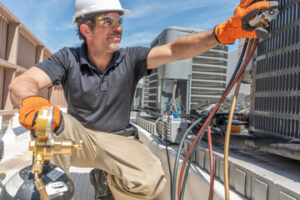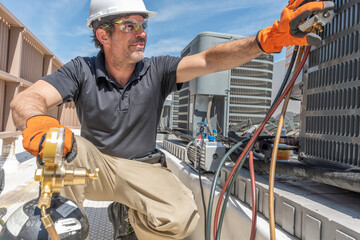Working as an HVAC technician isn’t for the faint of heart. Lifting heavy equipment, climbing ladders, and working inside ducts are all part of the job. HVAC technicians are often required to work in outdoor and commercial settings and are often exposed to extreme weather conditions. It’s also possible to become electrocuted while working on HVAC equipment, so proper safety precautions and training are essential. This career is highly skilled, but it does require extensive training.

Airflow in an HVAC system is important for comfort and efficiency. If the ductwork is improperly installed, it leads to hot and cold spots and higher bills. In order to ensure even distribution of air, dampers are installed at the trunks of ducts. As time goes on, deterioration of the ducts increases. HVAC professionals can fix problems and save you money in the long run by properly installing air-balancing ductwork.
HVAC is an important part of residential structures, medium-sized industrial buildings, large office buildings, and even cars and marine environments. Its function is to maintain temperature and humidity levels within a building and regulate humidity levels. It does this by circulating fresh air from outside. To keep the air in a building comfortable, HVAC systems must meet a variety of energy and budget constraints. The cost of electricity, water, and gas has skyrocketed in recent years, and modern HVAC systems must work smarter, not harder.
Heating, ventilation, and air conditioning are all aspects of the same system. HVAC technicians have extensive knowledge of these three systems. The most common types are heat pumps, furnaces, and cooling units. In addition to controlling temperature, HVAC units can improve indoor air quality with air cleaners. HVAC technicians can help you choose the right system for your home or office. If you’re interested in HVAC services, contact a local company today. You’ll be glad you did!
HVAC contractors and facility managers can take steps to minimize the risk of exposure to volatile organic contaminants and gases by installing high-quality ductwork. The American Society of Heating, Refrigerating, and Air-conditioning Engineers (ASHRAE) recommends that classrooms have minimum ventilation rates of 15 cubic feet per minute. While this limit is a bit higher than the standard, it’s still achievable in many parts of the country with proper engineering principles.
A split HVAC system is another type of HVAC. It uses both indoor and outdoor units. The indoor unit contains a furnace, evaporator coil, and compressor. The outdoor unit uses a compressor, coils, and refrigerant to move air in and out of the home. A thermostat is used to control the temperature and regulate the system. It also contains a fan to direct hot air out of the building. HVAC systems can be costly to install, but if you choose the right system, you’ll be pleasantly surprised at the results.
Another type of HVAC system is known as a heat pump. These systems work very similarly to air conditioners, except that heat pumps can also move heat. They are paired with electric or gas furnaces to make the best use of space in a home. The furnace uses electrical energy to generate heat, and a heat pump collects heat from the outdoors and transfers it to the indoor unit. The system is then switched on. They can be used separately or together, but these two types are very similar.
HVAC systems are vital to the comfort of indoor environments. They manage the temperature, humidity, and air purity in buildings. Their goal is to maintain thermal comfort and acceptable indoor air quality. HVAC systems are a subfield of mechanical engineering. The science behind HVAC system design involves heat transfer, fluid mechanics, and thermodynamics. HVAC systems are often abbreviated with “refrigeration” or “ventilation” to emphasize the two important parts of the system.
Some buildings may use local HVAC systems. These serve a single zone instead of a full-building system. The types of local HVAC systems are listed in Figure 12.
